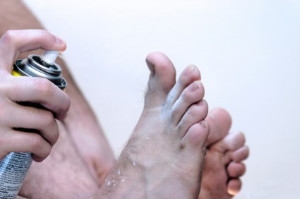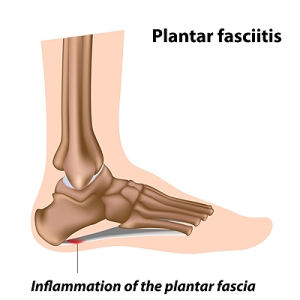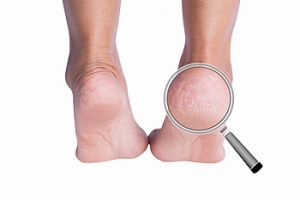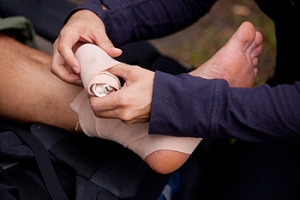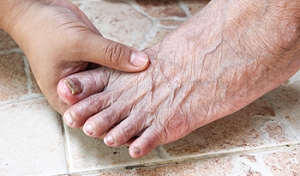Connect With Us
Blog

Athlete’s Foot May Cause Severe Itching
 The medical condition that is known as athlete’s foot can cause the foot to become itchy and uncomfortable. It typically affects the skin between the toes and the bottom of the feet. It is caused by a fungus that lives and thrives in moist and warm environments. These can include wearing socks and shoes that are wet, public swimming pools, and communal shower rooms. Patients may find relief when an antifungal powder is used, and this may help to relieve a portion of the itching and swelling that may accompany athlete’s foot. It is beneficial to wear appropriate shoes while in these areas, in addition to alternating shoes which can help them to dry out. If you have symptoms of athletes’ foot, it is suggested that you seek the counsel of a podiatrist, who can offer the best treatment options for you, which may include prescribed medication.
The medical condition that is known as athlete’s foot can cause the foot to become itchy and uncomfortable. It typically affects the skin between the toes and the bottom of the feet. It is caused by a fungus that lives and thrives in moist and warm environments. These can include wearing socks and shoes that are wet, public swimming pools, and communal shower rooms. Patients may find relief when an antifungal powder is used, and this may help to relieve a portion of the itching and swelling that may accompany athlete’s foot. It is beneficial to wear appropriate shoes while in these areas, in addition to alternating shoes which can help them to dry out. If you have symptoms of athletes’ foot, it is suggested that you seek the counsel of a podiatrist, who can offer the best treatment options for you, which may include prescribed medication.
Athlete’s foot is an inconvenient condition that can be easily reduced with the proper treatment. If you have any concerns about your feet and ankles, contact one of our podiatrists from Family Foot Care of Long Island. Our doctors will treat your foot and ankle needs.
Athlete’s Foot: The Sole Story
Athlete's foot, also known as tinea pedis, can be an extremely contagious foot infection. It is commonly contracted in public changing areas and bathrooms, dormitory style living quarters, around locker rooms and public swimming pools, or anywhere your feet often come into contact with other people.
Solutions to Combat Athlete’s Foot
- Hydrate your feet by using lotion
- Exfoliate
- Buff off nails
- Use of anti-fungal products
- Examine your feet and visit your doctor if any suspicious blisters or cuts develop
Athlete’s foot can cause many irritating symptoms such as dry and flaking skin, itching, and redness. Some more severe symptoms can include bleeding and cracked skin, intense itching and burning, and even pain when walking. In the worst cases, Athlete’s foot can cause blistering as well. Speak to your podiatrist for a better understanding of the different causes of Athlete’s foot, as well as help in determining which treatment options are best for you.
If you have any questions please feel free to contact our office located in Port Jefferson Station, NY . We offer the newest diagnostic and treatment technologies for all your foot and ankle needs.
How to Deal with Athlete's Foot
Athlete’s foot is a type of fungal infection that affects the skin on the feet. It is caused when the tinea fungus grows on the foot. It is possible to catch the fungus through direct contact with someone who has it or by touching a surface that is contaminated with it. This type of fungus thrives in warm, moist environments such as showers, locker room floors, and swimming pools. Your risk of getting it may also increase by wearing tight-fitting, closed-toe shoes, or by having sweaty feet.
Symptoms of athlete’s foot include itching, stinging or burning sensations between the toes. You may also experience toenails that are discolored, thick, crumbly, or toenails that pull away from the nail bed.
Your podiatrist may diagnose athlete’s foot by detecting these symptoms or by doing a skin test to see if there is a fungal infection present. The most common exam used to detect Athlete’s foot is a skin lesion potassium hydroxide exam. To use this method, your doctor will scrape off a small area of the infected skin and place it into potassium hydroxide. The potassium hydroxide will destroy the normal cells and leave the fungal cells untouched so that they are visible under a microscope.
There are a variety of treatment options for athlete’s foot. Some medications are miconazole (Desenex), terbinafine (Lamisil AT), clotrimazole (Lotrimin AF), butenafine (Lotrimin Ultra), and tolnaftate (Tinactin). While these options may be able to treat your fungus, it is best that you consult with a podiatrist in order to see which treatment option may work best for you.
In some cases, Athlete’s foot may lead to complications. A severe complication would be a secondary bacterial infection which may cause your foot to become swollen, painful, and hot.
There are ways that you can prevent athlete’s foot. Washing your feet with soap and water each day and drying them thoroughly is an effective way to prevent infections. You also shouldn’t share socks, shoes, or towels with other people. It is crucial that you wear shower sandals in public showers, around swimming pools, and in other public places. Additionally, you should make sure you wear shoes that can breathe and change your socks when your feet become sweaty. If you suspect that you have Athlete’s foot, you should seek help from a podiatrist as soon as possible.
Heel Pain and Plantar Fasciitis
 The plantar fascia is located on the sole of the foot, and its function is to connect the heel to the toes. The chronic foot condition that is known as plantar fasciitis can develop from wearing shoes that do not fit correctly, or from standing on hard surfaces for the majority of the day. This may cause the plantar fascia to become inflamed. A common symptom that patients often notice is severe heel pain that may be more pronounced in the morning after arising. An effective prevention technique can be stretching the calf muscles. This can be practiced by standing on a step, and gently lowering one heel at a time. Additionally, it may help to roll the affected foot on a tennis ball, and this may help to stretch the heel. If you are experiencing heel pain, it may be indicative of plantar fasciitis, and it is advised that you seek the counsel of a podiatrist.
The plantar fascia is located on the sole of the foot, and its function is to connect the heel to the toes. The chronic foot condition that is known as plantar fasciitis can develop from wearing shoes that do not fit correctly, or from standing on hard surfaces for the majority of the day. This may cause the plantar fascia to become inflamed. A common symptom that patients often notice is severe heel pain that may be more pronounced in the morning after arising. An effective prevention technique can be stretching the calf muscles. This can be practiced by standing on a step, and gently lowering one heel at a time. Additionally, it may help to roll the affected foot on a tennis ball, and this may help to stretch the heel. If you are experiencing heel pain, it may be indicative of plantar fasciitis, and it is advised that you seek the counsel of a podiatrist.
Plantar fasciitis is a common foot condition that is often caused by a strain injury. If you are experiencing heel pain or symptoms of plantar fasciitis, contact one of our podiatrists from Family Foot Care of Long Island. Our doctors can provide the care you need to keep you pain-free and on your feet.
What Is Plantar Fasciitis?
Plantar fasciitis is one of the most common causes of heel pain. The plantar fascia is a ligament that connects your heel to the front of your foot. When this ligament becomes inflamed, plantar fasciitis is the result. If you have plantar fasciitis you will have a stabbing pain that usually occurs with your first steps in the morning. As the day progresses and you walk around more, this pain will start to disappear, but it will return after long periods of standing or sitting.
What Causes Plantar Fasciitis?
- Excessive running
- Having high arches in your feet
- Other foot issues such as flat feet
- Pregnancy (due to the sudden weight gain)
- Being on your feet very often
There are some risk factors that may make you more likely to develop plantar fasciitis compared to others. The condition most commonly affects adults between the ages of 40 and 60. It also tends to affect people who are obese because the extra pounds result in extra stress being placed on the plantar fascia.
Prevention
- Take good care of your feet – Wear shoes that have good arch support and heel cushioning.
- Maintain a healthy weight
- If you are a runner, alternate running with other sports that won’t cause heel pain
There are a variety of treatment options available for plantar fasciitis along with the pain that accompanies it. Additionally, physical therapy is a very important component in the treatment process. It is important that you meet with your podiatrist to determine which treatment option is best for you.
If you have any questions, please feel free to contact our office located in Port Jefferson Station, NY . We offer the newest diagnostic and treatment technologies for all your foot care needs.
Plantar Fasciitis
Plantar fasciitis is one of the most common causes of heel pain. The plantar fascia is the thick band of tissue that connects the heel bone to the toes. When this band of connective tissue becomes inflamed, plantar fasciitis occurs. Fortunately, this condition is treatable.
There are several factors that may put you at a greater risk for developing plantar fasciitis. One of the biggest factors is age; plantar fasciitis is common in those between the ages of 40 to 60. People who have jobs that require them to be on their feet are also likely to develop plantar fasciitis. This includes factory workers, teachers, and others who spend a large portion of their day walking around on hard surfaces. Another risk factor is obesity because excess weight can result in extra stress being placed on the plantar fascia.
People with plantar fasciitis often experience a stabbing pain in the heel area. This pain is usually at its worst in the morning, but can also be triggered by periods of standing or sitting. Plantar fasciitis may make it hard to run and walk. It may also make the foot feel stiff and sensitive, which consequently makes walking barefoot difficult.
Treatment for plantar fasciitis depends on the severity of the specific case of the condition. Ice massage applications may be used to reduce pain and inflammation. Physical therapy is often used to treat plantar fasciitis, and this may include stretching exercises. Another treatment option is anti-inflammatory medication, such as ibuprofen.
If you suspect that you have plantar fasciitis, meet with your podiatrist immediately. If left untreated, symptoms may lead to tearing and overstretching of the plantar fascia. The solution is early detection and treatment. Be sure to speak with your podiatrist if you are experiencing heel pain.
How do Cracked Heels Develop?
 Fissures, also known as deep cracks, can develop in the skin of the heel. They can cause pain and discomfort, and in severe cases, bleeding may occur. Cracked heels can develop as a result of dry skin, but can also be caused due to a variety of reasons. These can include standing on hard surfaces for the majority of the day, or from specific medical conditions such as psoriasis and eczema. Additionally, patients who are overweight may develop this condition as a result of the added weight the feet endure. Many patients find mild relief when the feet are soaked in warm water, followed by applying a good moisturizer. If you have cracked heels, it is suggested that you schedule an appointment with a podiatrist who can guide you toward proper maintenance advice and possible prevention techniques.
Fissures, also known as deep cracks, can develop in the skin of the heel. They can cause pain and discomfort, and in severe cases, bleeding may occur. Cracked heels can develop as a result of dry skin, but can also be caused due to a variety of reasons. These can include standing on hard surfaces for the majority of the day, or from specific medical conditions such as psoriasis and eczema. Additionally, patients who are overweight may develop this condition as a result of the added weight the feet endure. Many patients find mild relief when the feet are soaked in warm water, followed by applying a good moisturizer. If you have cracked heels, it is suggested that you schedule an appointment with a podiatrist who can guide you toward proper maintenance advice and possible prevention techniques.
If the skin on your feet starts to crack, you may want to see a podiatrist to find treatment. If you have any concerns, contact one of our podiatrists from Family Foot Care of Long Island. Our doctors can provide the care you need to keep you pain-free and on your feet.
Cracked Heels
It is important to moisturize your cracked heels in order to prevent pain, bleeding, and infection. The reason cracked heels form is because the skin on the foot is too dry to support the immense pressure placed on them. When the foot expands, the dry skin on the foot begins to split.
Ways to Help Heal Them
- Invest in a good foot cream
- Try Using Petroleum Jelly
- Ease up on Soaps
- Drink Plenty of Water
Ways to Prevent Cracked Heels
- Moisturize After Showering
- Skip a Shower
- Keep Shower Water Lukewarm
- Don’t Scrub Your Feet
If you are unsure how to proceed in treating cracked heels, seek guidance from a podiatrist. Your doctor will help you with any questions or information you may need.
If you have any questions, please feel free to contact our office located in Port Jefferson Station, NY . We offer the newest diagnostic and treatment technologies for all your foot care needs.
Solutions for Cracked Heels
Cracked heels can make life very frustrating and embarrassing when displaying the bare feet. Aside from being unpleasing to the eye, they can also tear stockings and socks and wear out shoes at a faster rate. When severe, cracked heels may cause pain or infection.
Cracked heels are a problem for those who are athletic, those who may walk a lot, and those who have especially dry skin. Those who use medication that dry the skin, those who swim often, wearing certain types of shoes, and those who are diabetic may have trouble with cracked heels. Seniors whose skin produces less oil may also have trouble with cracked feet. There is no one way to develop cracked feet, and there is no cure.
Today, the market consists of numerous products that have a variety of ingredients to promote healing. Some of these are over-the-counter. Others are prescribed by a doctor, especially for those who have chronic dry feet and heels.
Some doctors recommend wearing socks at night for those with rough skin. This helps further healing, and helps creams stay on longer and better absorb into the skin.
One way to alleviate dryness that causes cracked heels is by using moisturizers both day and night. Another way is to make sure the skin is clean and dry at all times. Using a pumice stone to buff away dead skin before putting on moisturizer can also help. Cracked heels will not respond to the cream unless the outer layer of skin is first removed through exfoliation. After exfoliation, lotion or ointment will be absorbed by the skin more easily.
Foods that produce healing and balance can also help the skin from within. Everything that is put into the body can either help it or hurt it. Taking supplements of omega-3 fatty acids and zinc can also be very beneficial.
Nevertheless, not all products are guaranteed to help treat cracked feet. Seeing a professional is best if other treatments options were unsuccessful. A podiatrist should be able to give the best advice to help with this problem.
Did I Sprain My Ankle?
 An ankle sprain is one of the most common sports injuries that can occur. Ankle sprains take place when the ligaments that support the ankle are twisted or stretched too far and ultimately tear. The severity of the injury is determined by the amount of ligament damage at the time of injury. Common signs of a sprained ankle include swelling, tenderness, bruising, skin discoloration, pain, stiffness, and being unable to put weight on the affected ankle. Because a more severe sprain can weaken the ankle and lead to future sprains, it is important to visit a podiatrist who can help diagnose and treat your injury. Common treatments may include an ankle brace, rest, ice and physical therapy.
An ankle sprain is one of the most common sports injuries that can occur. Ankle sprains take place when the ligaments that support the ankle are twisted or stretched too far and ultimately tear. The severity of the injury is determined by the amount of ligament damage at the time of injury. Common signs of a sprained ankle include swelling, tenderness, bruising, skin discoloration, pain, stiffness, and being unable to put weight on the affected ankle. Because a more severe sprain can weaken the ankle and lead to future sprains, it is important to visit a podiatrist who can help diagnose and treat your injury. Common treatments may include an ankle brace, rest, ice and physical therapy.
Although ankle sprains are common, they aren’t always minor injuries. If you need your ankle injury looked at, contact one of our podiatrists from Family Foot Care of Long Island. Our doctors can provide the care you need to keep you pain-free and on your feet.
How Does an Ankle Sprain Occur?
Ankle sprains are the result of a tear in the ligaments within the ankle. These injuries may happen when you make a rapid shifting movement while your foot is planted. A less common way to sprain your ankle is when your ankle rolls inward while your foot turns outward.
What Are the Symptoms?
- Pain at the sight of the tear
- Bruising/Swelling
- Ankle area is tender to touch
- In severe cases, may hear/feel something tear
- Skin discoloration
Preventing a Sprain
- Wearing appropriate shoes for the occasion
- Stretching before exercises and sports
- Knowing your limits
Treatment of a Sprain
In many cases, the RICE method (Rest, Ice, Compression, and Elevate) is used to treat ankle sprains. However, you should see a podiatrist to see which treatment option would work best with your injury. In severe cases, surgery may be required.
It is important to ask your doctor about rehab options after you receive treatment for your injury. Stretching, strength training, and balance exercises may help the ankle heal while also preventing further injury.
If you have any questions, please feel free to contact our office located in Port Jefferson Station, NY . We offer the newest diagnostic and treatment technologies for all your foot care needs.
Ankle Sprains
Although ankle sprains may not be as serious as a broken ankle, they should be given immediate attention and care. An ankle sprain can lead to a significant amount of pain, as well as limited mobility. They are often characterized by the swelling and discoloration of the skin. This occurs when the ligaments are stretched beyond their limits.
The simple act of walking can sometimes cause a sprain, which makes ankle sprains a very common injury that can happen to anyone. They occur when the ankle twists in an awkward way or rolls over itself, causing a pop or snap in the tendons around the ankle. Some people are more at risk than others. These include athletes who continually push their bodies to the limits and also people who have previously suffered accidents to the feet, ankles, or lower legs.
Most of the time, an ankle sprain is not severe enough for hospital attention. There are many at-home treatment options available, including propping the leg up above your head to reduce blood flow and inflammation, applying ice packs to the affected area as needed, taking over-the-counter pain relievers and anti-inflammatory medication, using an ACE bandage to wrap and support the injured ankle, and most importantly, remaining off your feet until the ankle has fully healed.
Despite this, an ankle sprain can turn into a severe injury that might require hospitalization. If the ankle ligaments or muscles are damaged from a tear or rip, that is one sign that the sprain is severe enough for hospital attention and possibly for surgery. Even after the surgery, the recovery process can be long. You may need to have rehabilitation sessions administered by your podiatrist to get your ankle back to full health.
The severity of your sprain might become apparent if you are unable to stand or walk, consistent pain occurs over a prolonged period of time, swelling is much more severe than initially present, or if you start to experience tingling or numbness. These signs may indicate that your ankle sprain might actually be a broken ankle, an injury that requires immediate medical attention.
Although they are not completely avoidable, ankle sprains can be curbed with some preventative treatment measures. These include wearing appropriate-fitting shoes that not only provide a comfortable fit, but also ankle support. It is also recommended to stretch before doing any kind of physical activity, as this will help lower your body’s chance for an injury.
Foot Problem Prevention for Elders
 Foot ailments can become more common as we age. To decrease the likelihood of developing various foot problems, it is important to take care of your feet. Wearing the right shoes is of the utmost importance. Shoes that are too tight can increase the risk of foot pain, hammertoes, bunions, and blisters, while shoes that are too loose can lead to a fall. It is recommended that you wear comfortable, properly fitted shoes that give your toes room to move. Keeping your feet well-moisturized can prevent corns and calluses, while cutting your toenails regularly can prevent ingrown nails. Another thing that you can do to benefit your feet is to stretch them. Flex and wiggle your toes and walk regularly to help maintain foot strength and flexibility. If you develop foot problems, it is recommended that you see a podiatrist, who can diagnose and treat your condition.
Foot ailments can become more common as we age. To decrease the likelihood of developing various foot problems, it is important to take care of your feet. Wearing the right shoes is of the utmost importance. Shoes that are too tight can increase the risk of foot pain, hammertoes, bunions, and blisters, while shoes that are too loose can lead to a fall. It is recommended that you wear comfortable, properly fitted shoes that give your toes room to move. Keeping your feet well-moisturized can prevent corns and calluses, while cutting your toenails regularly can prevent ingrown nails. Another thing that you can do to benefit your feet is to stretch them. Flex and wiggle your toes and walk regularly to help maintain foot strength and flexibility. If you develop foot problems, it is recommended that you see a podiatrist, who can diagnose and treat your condition.
Proper foot care is something many older adults forget to consider. If you have any concerns about your feet and ankles, contact one of our podiatrists from Family Foot Care of Long Island. Our doctors can provide the care you need to keep you pain-free and on your feet.
The Elderly and Their Feet
As we age we start to notice many changes in our body, but the elder population may not notice them right away. Medical conditions may prevent the elderly to take notice of their foot health right away. Poor vision is a lead contributor to not taking action for the elderly.
Common Conditions
- Neuropathy – can reduce feeling in the feet and can hide many life-threatening medical conditions.
- Reduced flexibility – prevents the ability of proper toenail trimming, and foot cleaning. If left untreated, it may lead to further medical issues.
- Foot sores – amongst the older population can be serious before they are discovered. Some of the problematic conditions they may face are:
- Gouging toenails affecting nearby toe
- Shoes that don’t fit properly
- Pressure sores
- Loss of circulation in legs & feet
- Edema & swelling of feet and ankles
Susceptible Infections
Diabetes and poor circulation can cause general loss of sensitivity over the years, turning a simple cut into a serious issue.
If you have any questions please feel free to contact our office located in Port Jefferson Station, NY . We offer the newest diagnostic and treatment technologies for all your foot and ankle needs.
Blog Archives
- May 2025
- April 2025
- March 2025
- February 2025
- January 2025
- December 2024
- November 2024
- October 2024
- September 2024
- August 2024
- July 2024
- June 2024
- May 2024
- April 2024
- March 2024
- February 2024
- January 2024
- December 2023
- November 2023
- October 2023
- September 2023
- August 2023
- July 2023
- June 2023
- May 2023
- April 2023
- March 2023
- February 2023
- January 2023
- December 2022
- November 2022
- October 2022
- September 2022
- August 2022
- July 2022
- June 2022
- May 2022
- April 2022
- March 2022
- February 2022
- January 2022
- December 2021
- November 2021
- October 2021
- September 2021
- August 2021
- July 2021
- June 2021
- May 2021
- April 2021
- March 2021
- February 2021
- January 2021
- December 2020
- November 2020
- October 2020
- September 2020
- August 2020
- July 2020
- June 2020
- May 2020
- April 2020
- March 2020
- February 2020
- January 2020
- December 2019
- November 2019
- October 2019
- September 2019
- August 2019
- July 2019
- June 2019
- May 2019
- April 2019
- March 2019
- February 2019
- January 2019
- December 2018
- November 2018
- October 2018
- September 2018
- August 2018
- July 2018
- June 2018
- May 2018
- April 2018
- March 2018
- February 2018
- January 2018
- December 2017
- November 2017
- October 2017
- September 2017
